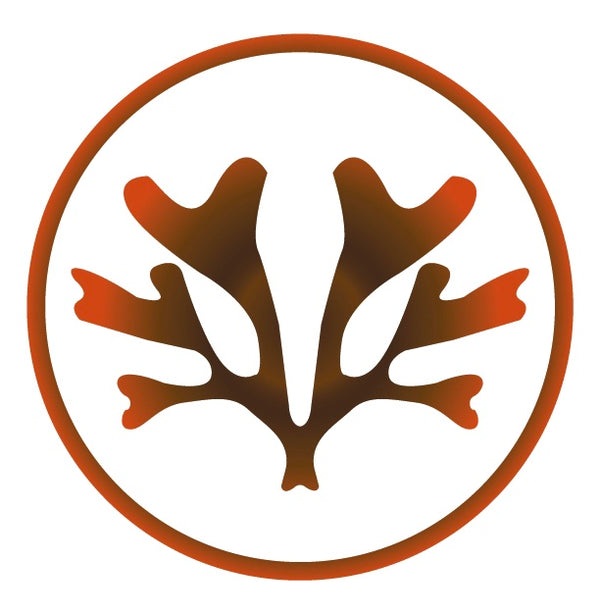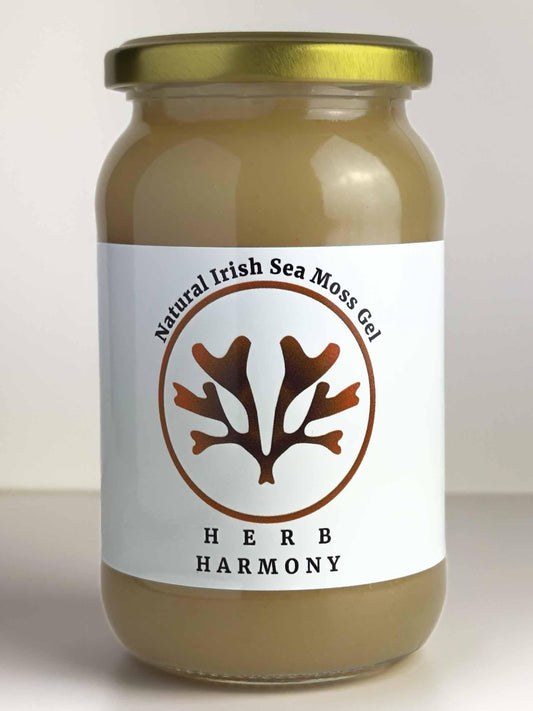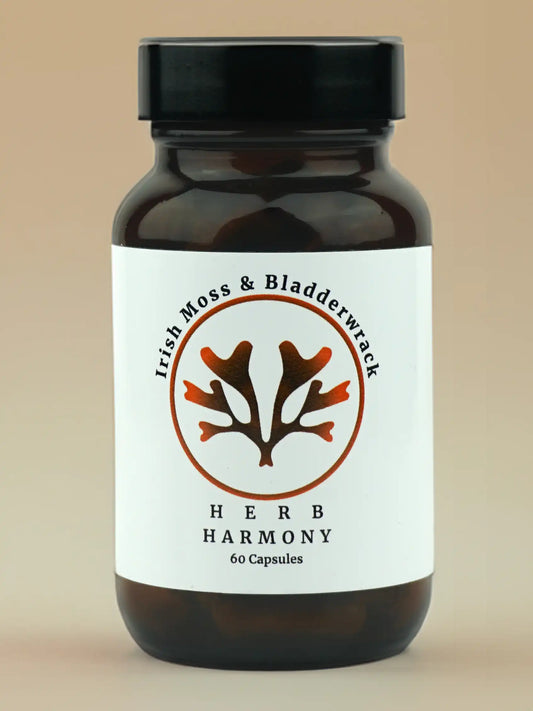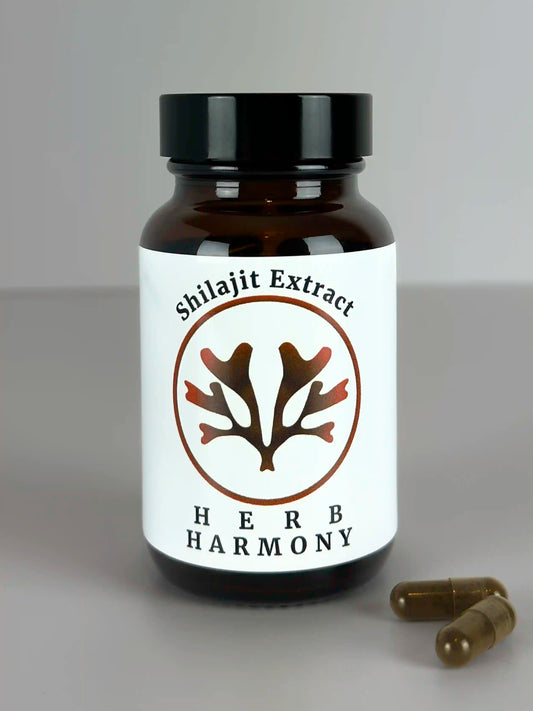Introduction:
Bladderwrack (scientifically known as Fucus vesiculosus) is a type of brown seaweed or algae that is commonly found along the coasts of the North Atlantic and North Pacific oceans. It is a marine plant that belongs to the Fucaceae family. Bladderwrack gets its name from the small air-filled bladders or vesicles present on its fronds, which help it float and stay close to the water's surface.

Image of bladderwrack attached to rock.
What are the benefits of bladderwrack?
Historically, bladderwrack has been used for various medicinal and nutritional purposes. It contains a range of beneficial compounds such as iodine, fucoidan, alginates, and other minerals and vitamins. Some of the traditional uses of bladderwrack include:- Thyroid health: Bladderwrack is a natural source of iodine, an essential mineral necessary for the proper functioning of the thyroid gland. As such, it has been used to support thyroid health and address conditions like iodine deficiency or mild hypothyroidism.
- Digestive health: Bladderwrack contains alginates, which are believed to have a soothing effect on the digestive tract and can help with conditions like heartburn and indigestion.
- Skin health: The fucoidan content in bladderwrack is thought to have potential benefits for skin health. It has been used in skincare products for its moisturizing and anti-inflammatory properties.
-
Nutritional supplement: Bladderwrack is also consumed as a dietary supplement due to its rich mineral and vitamin content.

Image of bladderwrack powder.
Fucoxanthin and its benefits:
Fucoxanthin is a natural carotenoid pigment that belongs to a group of chemicals known as xanthophylls. It is found in various types of brown seaweed, such as bladderwrack, wakame and hijiki as well as some marine microorganisms. The compound is responsible for the brownish color of these seaweeds.
Fucoxanthin has gained attention in recent years due to its potential health benefits, and some research suggests that it may offer several positive effects. Some of the proposed health benefits of fucoxanthin include:
1. Weight management: Fucoxanthin has been studied for its potential effects on weight loss and obesity. Some research in animal and cell studies suggests that it may help promote fat oxidation and thermogenesis, which could lead to increased metabolism and decreased fat accumulation.
2. Antioxidant properties: Fucoxanthin possesses strong antioxidant properties. Antioxidants help protect the body's cells from oxidative stress caused by free radicals, which are unstable molecules that can damage cells and contribute to various diseases and aging.
3. Anti-inflammatory effects: Some studies have indicated that fucoxanthin may have anti-inflammatory properties. Chronic inflammation is associated with several health issues, including cardiovascular diseases, arthritis, and certain cancers. By reducing inflammation, fucoxanthin might have a positive impact on overall health.
4. Potential anti-cancer properties: Preliminary research suggests that fucoxanthin might exhibit anti-cancer effects, particularly in certain types of cancer cells. However, this area of research is still in its infancy, and more studies are needed to understand its true potential in cancer prevention and treatment.
5. Liver health: Some animal studies have suggested that fucoxanthin might have a protective effect on the liver and could be beneficial in the management of non-alcoholic fatty liver disease (NAFLD). However, human studies are lacking, and more research is necessary to validate these findings.

Image of bladderwrack on sea shores.
What are the side effects of bladderwrack?
It's essential to be aware of possible side effects that may occur, particularly if taken in excessive amounts or by individuals with certain health conditions. Some potential side effects of bladderwrack include:
- Iodine toxicity: Bladderwrack is rich in iodine, which is essential for thyroid function. However, excessive iodine intake can lead to iodine toxicity, causing symptoms such as thyroid dysfunction, nausea, vomiting, and skin rashes.
- Allergic reactions: Some individuals may be allergic to seaweed or iodine. Allergic reactions to bladderwrack can manifest as skin irritation, itching, hives, or difficulty breathing.
- Interactions with medications: Bladderwrack might interact with certain medications, especially those used for thyroid disorders or blood-thinning medications. It could interfere with their effectiveness or lead to adverse effects.
- Pregnancy and breastfeeding concerns: Due to its high iodine content, bladderwrack is not recommended for pregnant or breastfeeding women as excess iodine intake can harm fetal or infant thyroid function.
- Heavy metal contamination: Seaweeds, including bladderwrack, can accumulate heavy metals and other environmental contaminants. Consuming contaminated bladderwrack can lead to heavy metal poisoning, causing various health issues. Some seaweed harvesters will do testing and can provide certificates of analysis to confirm that there are no contaminants and ensure it is safe for consumption. This is why it is important to get your seaweeds from a safe and reputable source.
If you're interested in incorporating brown seaweed into your diet for its potential health benefits, it's best to consult with a healthcare professional first, especially if you have any pre-existing health conditions or are taking medications. They can help determine if it is safe and appropriate for your specific situation and advise on the correct dosage to avoid potential side effects. Additionally, a well-balanced diet rich in fruits, vegetables, and whole foods remains the cornerstone of a healthy lifestyle.
Is Bladderwrack the same as Sargassum?
There has been some confusion around various brown seaweeds growing in Caribbean waters that have been labelled as bladderwrack. Sargassum is a type of brown macroalgae (seaweed) that is commonly found in the ocean. It belongs to the genus Sargassum, which includes numerous species.

Image of sargassum seaweed.
Sargassum has unique characteristics that distinguish it from other types of seaweed:
- Free-floating: Unlike most seaweeds that are attached to the ocean floor or other substrates, Sargassum is typically free-floating. It forms large mats or patches on the ocean's surface, known as "Sargassum mats" or "Sargasso Sea."
- Pelagic habitat: The Sargassum mats provide a floating habitat, known as a pelagic ecosystem, for a wide range of marine organisms, such as fish, turtles, and invertebrates. These mats can serve as nurseries and shelter for various species.
- Importance in marine ecosystems: Sargassum plays a crucial role in marine ecosystems. The floating mats provide food and shelter for various marine species and contribute to the overall biodiversity of the ocean.
- Distribution: Sargassum is found in tropical and subtropical regions around the world, including the Sargasso Sea in the North Atlantic Ocean, where it was first described by early explorers.
- While Sargassum is a natural and important part of marine ecosystems, in recent years, there have been instances of massive Sargassum blooms in certain regions, causing environmental challenges. These blooms can have negative impacts on coastal ecosystems, tourism, and local economies when they accumulate on beaches in large quantities. Efforts are ongoing to understand the causes of these blooms and find ways to manage their effects sustainably.




